California living in the Testa-Vought Garden: San Francisco Garden Bloggers Fling
Our 5th stop on the 2nd day of the San Francisco Garden Bloggers Fling was the Bernard Trainor-designed Testa-Vought Garden in Palo Alto. Out front, a contemporary gravel garden greets you, but the real excitement begins when you enter a walled courtyard and begin discovering a series of garden rooms designed to forge a connection between indoors and out.
In a beautifully photographed article for Pacific Horticulture, the owner, Andrea Testa-Vought, describes how the garden came to be. Under Trainor‘s hand, a yard with tired, thirsty roses, camellias, and lawn and a house with little connection to the outdoors were exchanged for bold Mediterranean-climate plants, low-walled garden rooms accessible from nearly every room in the house, and entertainment spaces (a swimming pool, bocce court, and dining area) for her family of four. (Aside from specifics of how the garden design originated, I urge you to read the article for the author’s observations on how a garden, even a masterfully designed one, must continue to evolve. Gardens are not static creations!)
I’m jumping past the first spaces — a dining area off the kitchen, an intimate side-yard patio, and a covered terrace — to show you the heart of the garden: the swimming pool garden. In this sunny space, succulents dominate the ground level while small trees like purple-spired vitex offer some shade and height.
Blue chalk sticks (Senecio mandraliscae) echoes the blue of the pool, which proved so refreshing on this hot day, as a half-dozen bloggers, at the owner’s invitation, sat on the edge and soaked their feet.
Several low walls of varying heights run behind the pool, providing shade at certain times of the day, reflective heat in cold months, and a putty-colored backdrop perfect for showing off the strong shapes of plants.
Agave attenuata and an otherworldly plant that I don’t know
Aloes colonize a shady space under a tree. The cut-out window in the wall draws your eye and makes you wonder what’s beyond.
Grevillea and agave
Looking past a clump of Agave attenuata — green tongues of flame — and across the pool, I play dueling cameras with Kylee.
The long view across the pool reveals a tiered screen of trees, with vitex and acacia (I think) below and granddaddy eucalyptus trees above.
Another view of the succulent corner
Like a boiled octopus, this stunning, potted aloe makes a pumpkin-orange focal point. Update: A possible ID is Aloe alooides. (Thanks, Tai!)
Shallow steps lead from the pool deck…
…to a bocce court at ground level with the house. Bocce courts are trendy playspaces, but this one is also a decorative element thanks to the dynamic lines of the arbor overhead. On either side, succulents and shrubs soften the packed-earth court. The owner says that the court has been a much-used playspace for her children as well as an impromptu dance floor during parties.
Looking the other way, you see the covered terrace along the back of the house.
Against the house, a small seating area offers a place to watch others play or rest between games. I first thought the tree in the foreground to be a manzanita, but after reading the Pacific Horticulture article I believe it may be a strawberry tree (Arbutus ‘Marina’).
Now we head back around toward the front of the house. Along the side, a branching aloe grows as if espaliered against a wall — a neat trick.
Tucked into a courtyard between wings of the house, a dining terrace is anchored by an iron-and-concrete table designed by Bernard Trainor for the space.
Vertical plants in a variety of pots provide interest at the door.
Geometric stone pavers provide firmer footing by the door and help keep gravel from getting tracked into the house.
Several of us sat at the table for a while, enjoying the garden and some tasty snacks the owners had provided for us. A friendly cat lounged on one of the benches.
Adore me, he seemed to say.
I can’t remember in which part of the garden I found this path of landscaping timbers and gravel, but I liked it.
Ornamentation in this garden is minimal but well placed, like this terracotta-pot water feature, which provides a simple but essential focal point from the dining patio. It’s one more beautiful feature in a garden that is obviously greatly enjoyed.
Up next: The desert-plant lover’s Ruth Bancroft Garden. For a look back at the memento-infused, inviting garden of Rebecca Sweet, click here.
All material © 2006-2013 by Pam Penick for Digging. Unauthorized reproduction prohibited.


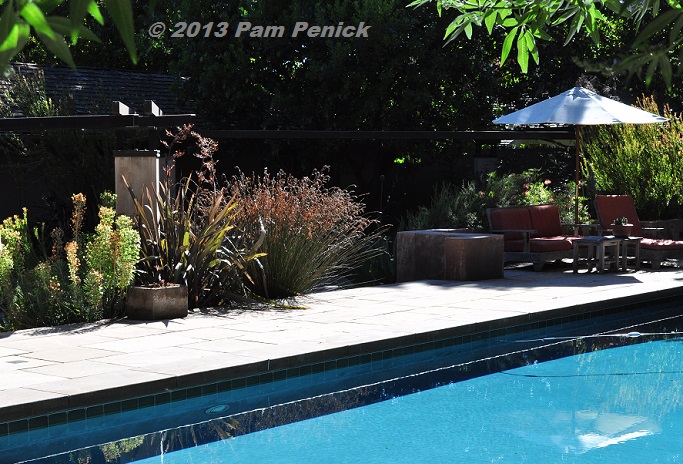
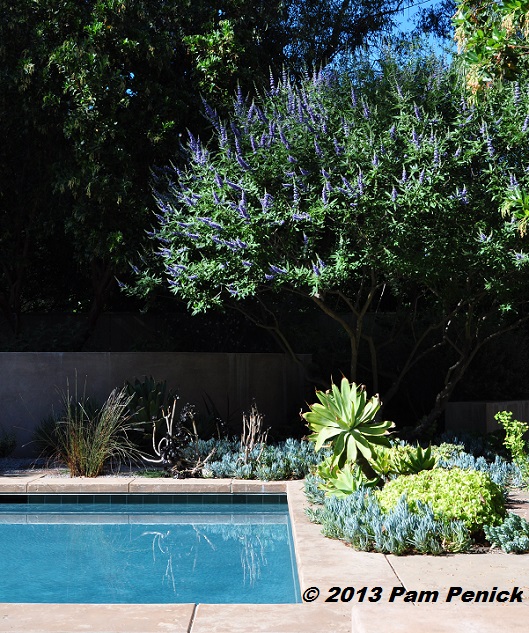
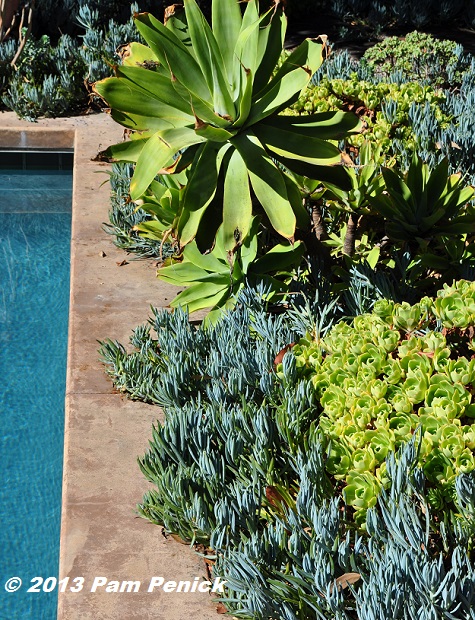
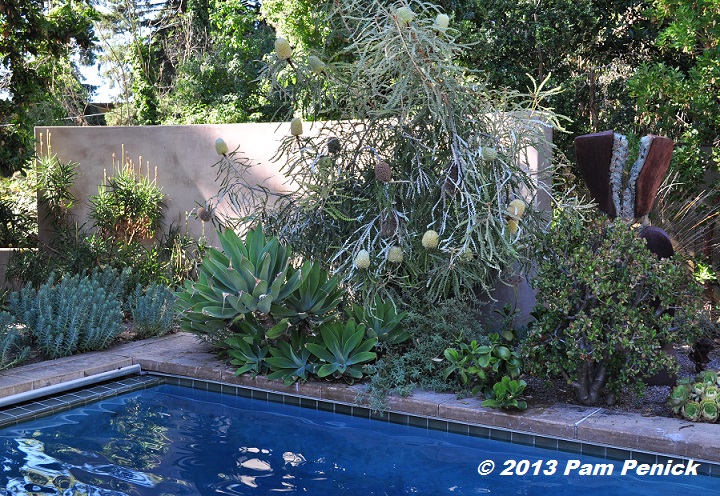
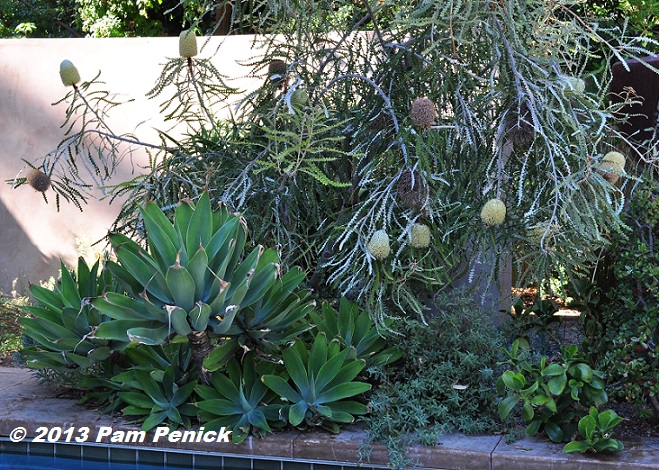
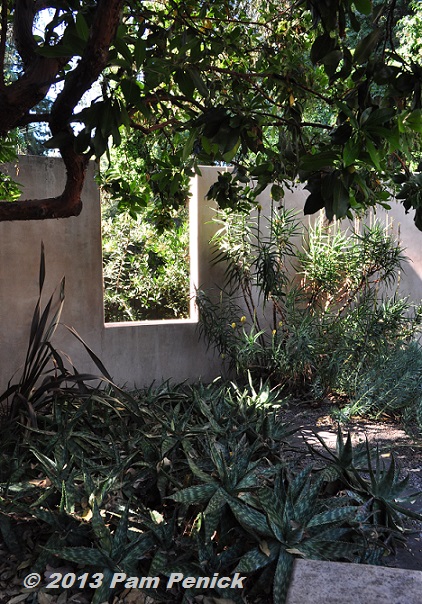
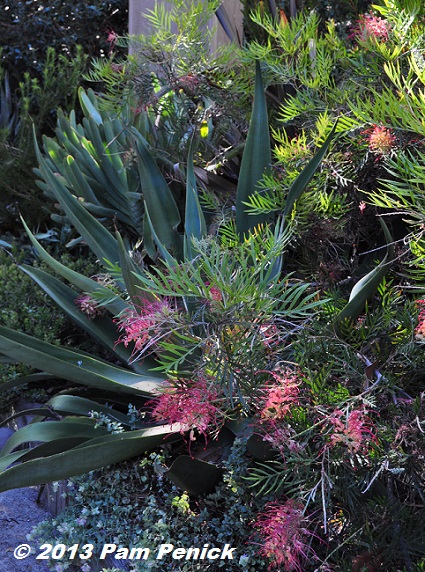
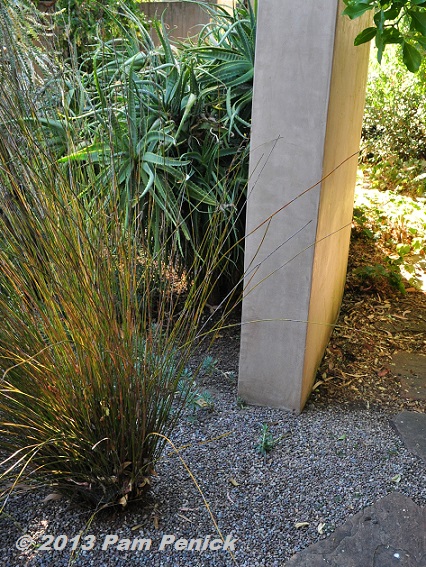
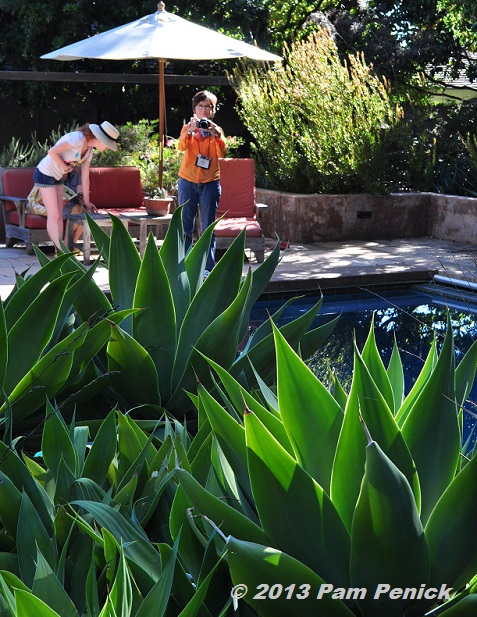
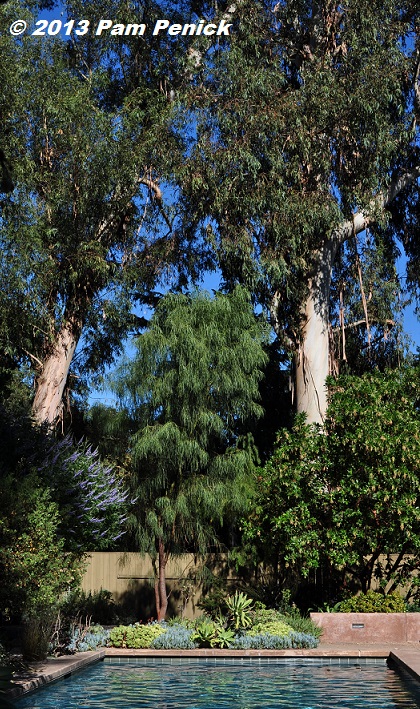
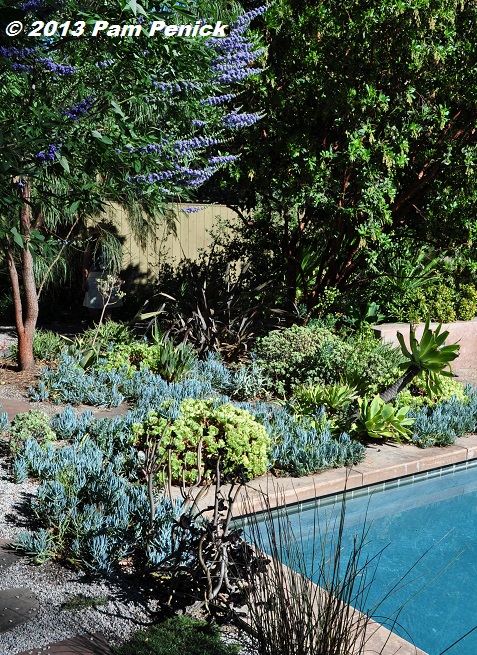
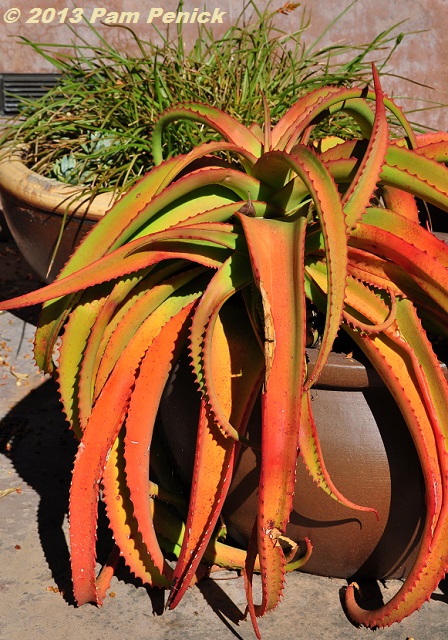
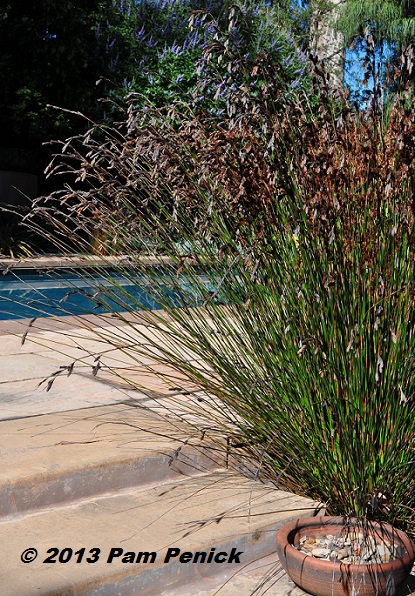
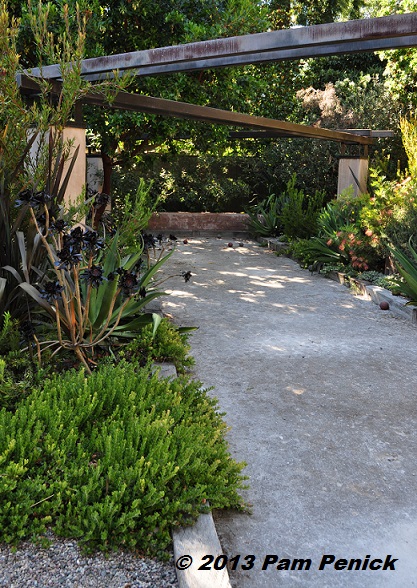
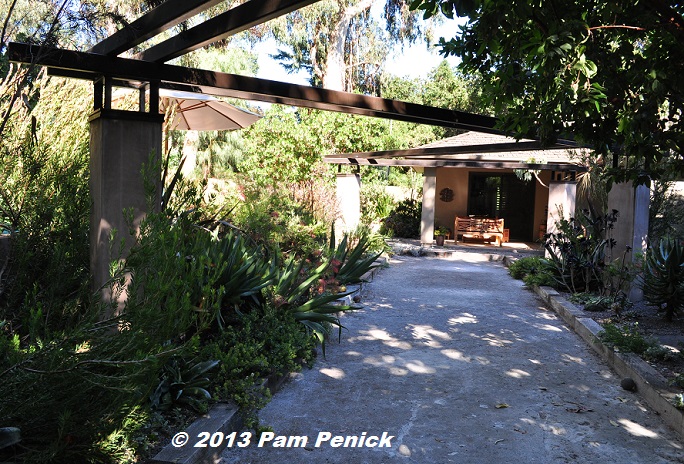
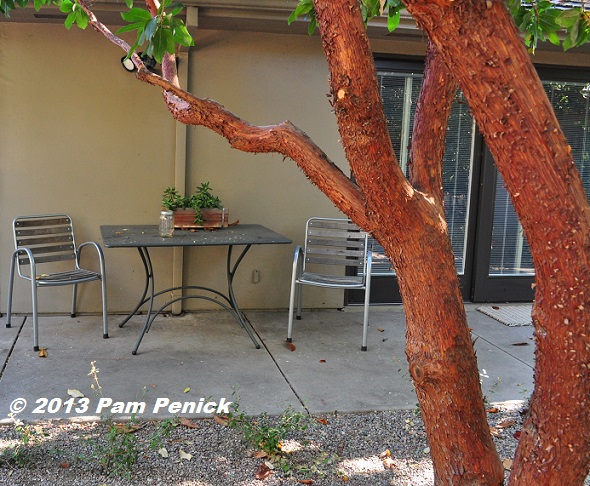
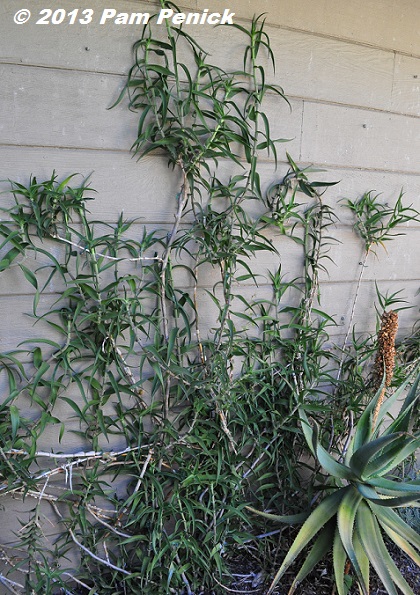
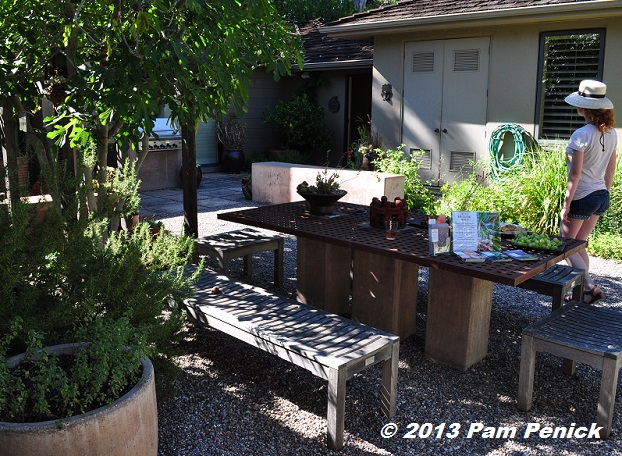
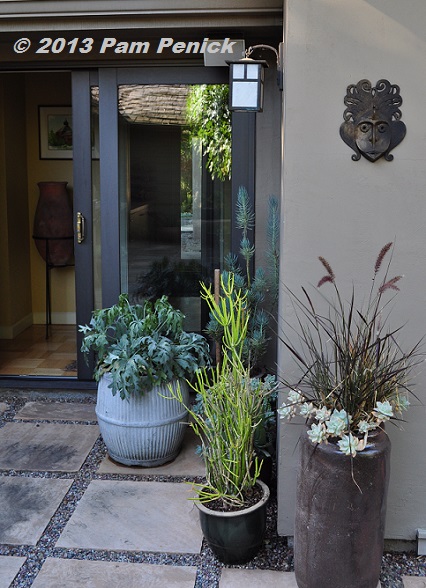
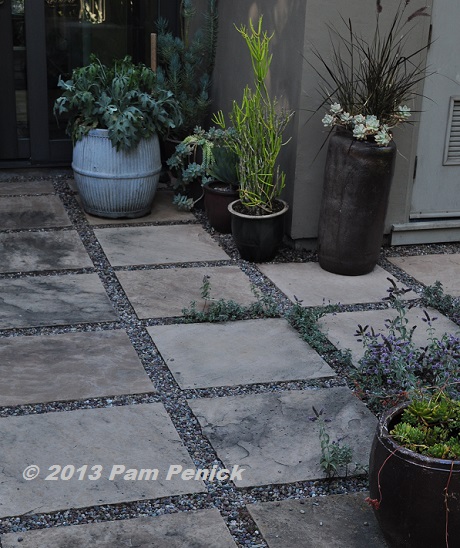
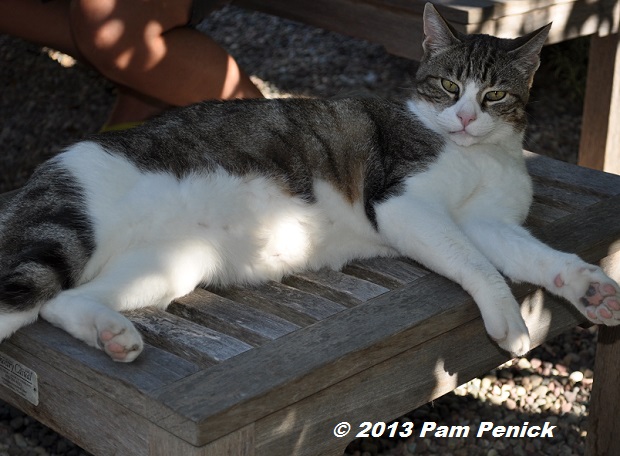
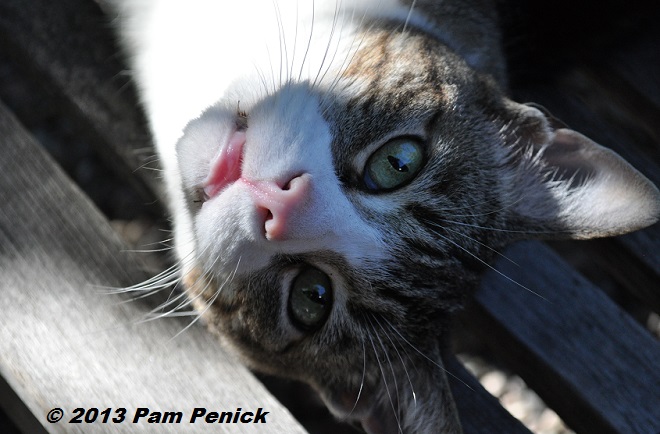
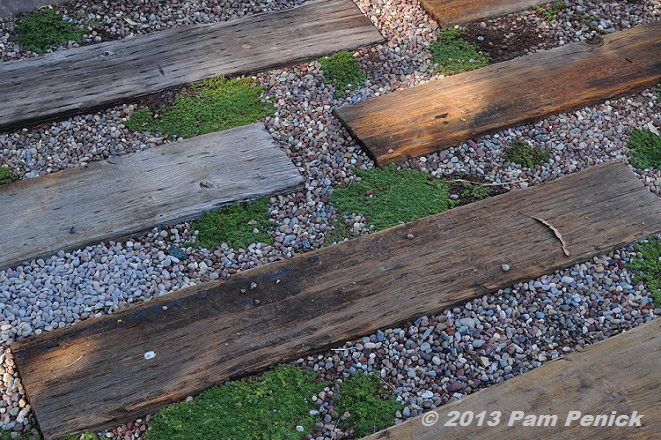
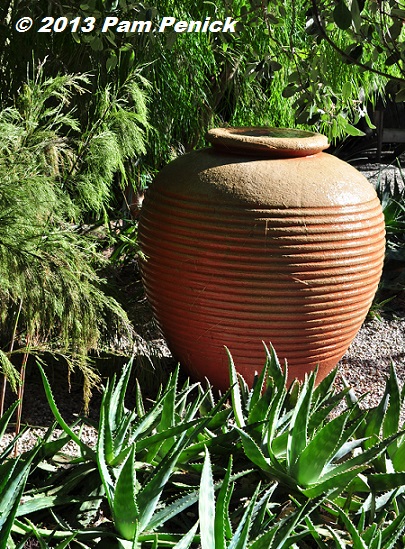
Excellent post! I didn’t understand the purpose of those free-standing concrete walls, but you point out that they provide shade at certain parts of the day. To me, they just seemed to get in the way of spots where I could have planted stuff. So I kind of didn’t “get” this garden. Like that cutout window that draws your attention to what’s beyond. Are you supposed to then step through? A door would have drawn your eye too, and would have been easier to negotiate. Thanks so much for sharing your insights into the design of this garden, they were helpful.
Hi, Alison! I appreciate your honest opinion about not getting this garden. To me the real value of the walls is the spatial definition they provide and neutral backdrop that makes those strong-shaped desert plants just pop. Walls like these are quite common in desert climates (based on what I saw in Tucson last fall), so maybe it’s just a different design vernacular than you’re used to in the Pacific NW? Anyway, thanks for prompting me to think it through again. —Pam
Lovely photos! I soo wish I had a pool!! Really like the octopus aloe, I’ve not seen one like that before. Looks like a great garden to relax in.
It was, and we did! I covet that aloe too. —Pam
Great post, Pam…it’s always interesting to see your take of these gardens…you notice things I totally missed. I have to admit, this is one of the gardens that I didn’t connect with. I don’t know what it was, precisely, the plant palette, the materials used…I don’t know, it just felt a little too “design-y”, if that makes sense. It was beautiful, just in a cool, aloof sort of way (ironic, given the heat of the day)!
BTW, I think that amorphous, alien plant is a Banksia.
Interesting, Scott. You’re the second PacNWesterner to tell me you didn’t get this garden. I wonder if it’s a regional difference? It’s true that this one felt less like a personally designed homeowner’s garden (and of course it WAS professionally designed), and any personal touches were fairly restrained, so perhaps that’s what it was? Hey, thanks for the ID on that plant. —Pam
I liked the enclosure and almost cloistered feeling that the walls added to the garden. The hard flat surfaces of the walls allowed for some of the billowy and wild plants to fit in without having to be trimmed and tamed. I would wreck this place with a lack of restraint color-wise by painting the walls terra cotta and Little & Lewis blue. Tacky as I am, I’d be tempted to hang something from those overhead beams which would defeat the purpose of their clean diagonal lines.
YES, I loved the walls for those exact reasons! The rest of your comment absolutely cracked me up, Peter. I would probably paint those lovely walls too (I love painted walls in desert gardens; why not here??) — ha! I don’t know about hanging something from that arbor though. 😉 —Pam
You had me at the cat!
It was a charmer! —Pam
You got some lovely photos Pam, at just about the worst time of day ..I’m impressed ! I really loved this garden, but still it was not the garden I would have if my funding were unlimited .I often have to differentiate gardens I admire as a viewer or visitor, and those I would emulate..my problem is I like so, so many garden types -probably why mine is such a mish-mosh !
I love many different garden styles too, Kathy, which is one of the reasons tours are so much fun. It’s like trying on someone else’s clothes, just to see. You may decide it’s not your style, but there’s always something to admire or learn from in any well-designed garden. —Pam
I liked the free-standing wall with cutout window, the espaliered branched aloe, the eucalyptus trees at the end of the pool, the bocee court….it is all rather exotic to this NE Indiana resident. Hard to translate into my region, but certainly easy to appreciate!
It’s interesting and eye-opening to see the garden vernacular of other regions, isn’t it? That’s one reason I enjoy the Fling so much. —Pam
OK…I’m in love with that orange aloe! Do you think they would survive in Texas?
I think I like the idea of all the succulents around the pool. So many times people overplant around a pool or plant stuff that makes maintenance a pain. This was very clever.
I “get” the walls. It allows you to enjoy each vignette. Not my kind of garden, but I love a lot of the plant choices.
I don’t know what kind of aloe that is, Chris, but it is a beauty. Likely the strong orange coloring is due to sun or drought stress. You might check with the Austin Succulent Society for a list of aloes that grow well in Austin. —Pam
Hmm, I didn’t see that timber and gravel path either but I like it! I love that photo of the orange aloe. I’m sure you were as enamored of all the succulents in the gardens as I was!
I wonder if the timber path was in the front yard? Maybe another reader will remember. —Pam
otherworldly is an Australian protea, a Banksia – as an earlier commenter said.
The ‘espaliered’ aloe is a climbing or tree aloe. Aloe ciliaris. In the wild it climbs up and thru its neighbours.
Thanks for the plant IDs, Diana. —Pam
I think it might be a Banksia attenuata, as the leaves seem too long for the commonly-cultivated Banksia serrata or B. aemula. But I could be wrong! It’s a lovely specimen, whatever it is.
I had better mention that while we have plenty of the Proteaceae in Australia, we have no native Proteas. The grevillea (another of the Proteaceae) looks like ‘Robyn Gordon’ — common as mud here, because it’s tough and free-flowering, and doesn’t grow too tall.
Does it seems strange to see so many Australian plants in a California garden, Chookie? You’d feel right at home in San Francisco. They love Aussie plants there! —Pam
I am dying to find out what the boiled octopus aloe is!? I have one like it, and would love to know its name.
I wish I could tell you, Karen. It was gorgeous! I assume the coloring was due to heat and drought stress. The Bay Area was having an extreme heat wave while we were there. —Pam